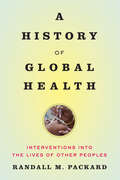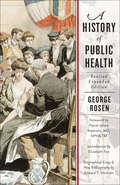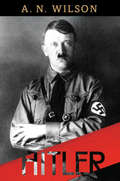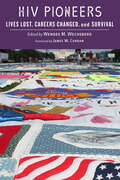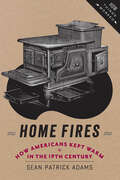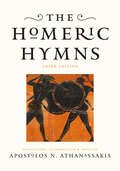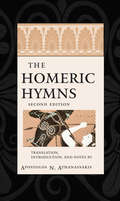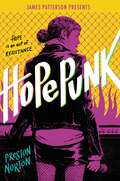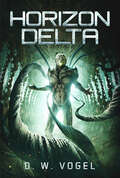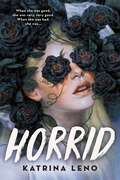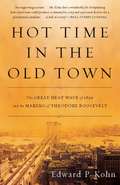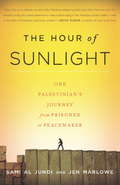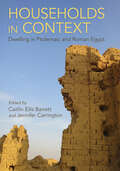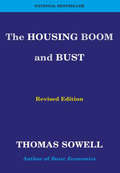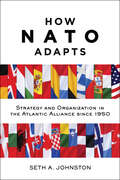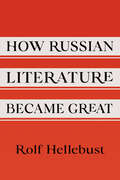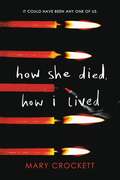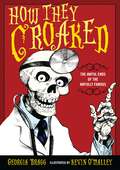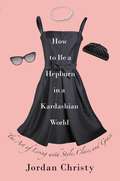- Table View
- List View
A History of Global Health: Interventions into the Lives of Other Peoples
by Randall M. PackardOver the past century, hundreds of billions of dollars have been invested in programs aimed at improving health on a global scale. Given the enormous scale and complexity of these lifesaving operations, why do millions of people in low-income countries continue to live without access to basic health services, sanitation, or clean water? And why are deadly diseases like Ebola able to spread so quickly among populations?In A History of Global Health, Randall M. Packard argues that global-health initiatives have saved millions of lives but have had limited impact on the overall health of people living in underdeveloped areas, where health-care workers are poorly paid, infrastructure and basic supplies such as disposable gloves, syringes, and bandages are lacking, and little effort has been made to address the underlying social and economic determinants of ill health. Global-health campaigns have relied on the application of biomedical technologies;¢;‚¬;€?vaccines, insecticide-treated nets, vitamin A capsules;¢;‚¬;€?to attack specific health problems but have failed to invest in building lasting infrastructure for managing the ongoing health problems of local populations.Designed to be read and taught, the book offers a critical historical view, providing historians, policy makers, researchers, program managers, and students with an essential new perspective on the formation and implementation of global-health policies and practices.
A History of Public Health
by George Rosen Edward T.. Morman New Bibliography by Edward T. Morman.Since publication in 1958, George Rosen’s classic book has been regarded as the essential international history of public health. Describing the development of public health in classical Greece, imperial Rome, England, Europe, the United States, and elsewhere, Rosen illuminates the lives and contributions of the field’s great figures. He considers such community health problems as infectious disease, water supply and sewage disposal, maternal and child health, nutrition, and occupational disease and injury. And he assesses the public health landscape of health education, public health administration, epidemiological theory, communicable disease control, medical care, statistics, public policy, and medical geography.Rosen, writing in the 1950s, may have had good reason to believe that infectious diseases would soon be conquered. But as Dr. Pascal James Imperato writes in the new foreword to this edition, infectious disease remains a grave threat. Globalization, antibiotic resistance, and the emergence of new pathogens and the reemergence of old ones, have returned public health efforts to the basics: preventing and controlling chronic and communicable diseases and shoring up public health infrastructures that provide potable water, sewage disposal, sanitary environments, and safe food and drug supplies to populations around the globe.A revised introduction by Elizabeth Fee frames the book within the context of the historiography of public health past, present, and future, and an updated bibliography by Edward T. Morman includes significant books on public health history published between 1958 and 2014. For seasoned professionals as well as students, A History of Public Health is visionary and essential reading.
Hitler: A Short Biography (Playaway Adult Nonfiction Ser.)
by A.N. Wilsoner's unlikely rise to power and his uncanny ability to manipulate his fellow man resulted in the deaths of millions of Europeans and a horrific world war, yet despite his colossal role in world history, he remains mythologized and, as a result, misunderstood. In Hitler, A.N. Wilson limns this mysterious figure with great verve and acuity, showing that it was Hitler's frightening normalcy-not some otherworldly evilness-that makes him so truly terrifying.
HIV Pioneers: Lives Lost, Careers Changed, and Survival
by Wendee M. Wechsberg James W. CurranTremendous strides have been made in the prevention and treatment of HIV since the disease first appeared in the 1980s. But because many of the people who studied and battled the virus in those early days are now gone, firsthand accounts are at risk of being lost. In HIV Pioneers, Wendee M. Wechsberg collects 29 "first stories" from the outset of the AIDS epidemic. These moving personal narratives and critical historical essays not only shed light on the experiences of global health pioneers, prominent scientists, and HIV survivors, but also preserve valuable lessons for managing the risk and impact of future epidemics.With unprecedented access to many key actors in the fight against AIDS and HIV, Wechsberg brings to life the harrowing reality of those early days of the epidemic. The book captures the experiences of those still working diligently and innovatively in the field, elevating the voices of doctors, scientists, and government bureaucrats alongside those of survivors and their loved ones. Focusing on the impact that the epidemic had on careers, pieces also show how governments responded to HIV, how research agendas were developed, and how AIDS service agencies and case management evolved.Illuminating the multiple facets of the HIV epidemic, both in the United States and across the globe, HIV Pioneers is a touching and inspirational look into the ongoing fight against HIV.Contributors: Quarraisha Abdool Karim, Salim S. Abdool Karim, Lynda Arnold, Anne Jeanene Bengoa, Robert E. Booth, Barry S. Brown, Thomas Coates, Francine Cournos, James W. Curran, Don C. Des Jarlais, Jeffrey D. Fisher, William A. Fisher, Samuel R. Friedman, Robert C. Gallo, Mary Guinan, Gibbie Harris, Warren W. Hewitt Jr., Susan M. Kegeles, Rayford Kytle, Bishop Stacey S. Latimer, Robert Love, Duane C. McBride, Clyde B. McCoy, Carmen Morris, Willo Pequegnat, Mary Jane Rotheram-Borus, Jeffrey Samet, David Serwadda, Lorraine Sherr, James L. Sorensen, Jack B. Stein, Charles van der Horst, Wendee M. Wechsberg, Wayne Wiebel, William A. Zule
HIV Pioneers: Lives Lost, Careers Changed, and Survival
by Wendee M. Wechsberg James W. CurranTremendous strides have been made in the prevention and treatment of HIV since the disease first appeared in the 1980s. But because many of the people who studied and battled the virus in those early days are now gone, firsthand accounts are at risk of being lost. In HIV Pioneers, Wendee M. Wechsberg collects 29 "first stories" from the outset of the AIDS epidemic. These moving personal narratives and critical historical essays not only shed light on the experiences of global health pioneers, prominent scientists, and HIV survivors, but also preserve valuable lessons for managing the risk and impact of future epidemics.With unprecedented access to many key actors in the fight against AIDS and HIV, Wechsberg brings to life the harrowing reality of those early days of the epidemic. The book captures the experiences of those still working diligently and innovatively in the field, elevating the voices of doctors, scientists, and government bureaucrats alongside those of survivors and their loved ones. Focusing on the impact that the epidemic had on careers, pieces also show how governments responded to HIV, how research agendas were developed, and how AIDS service agencies and case management evolved.Illuminating the multiple facets of the HIV epidemic, both in the United States and across the globe, HIV Pioneers is a touching and inspirational look into the ongoing fight against HIV.Contributors: Quarraisha Abdool Karim, Salim S. Abdool Karim, Lynda Arnold, Anne Jeanene Bengoa, Robert E. Booth, Barry S. Brown, Thomas Coates, Francine Cournos, James W. Curran, Don C. Des Jarlais, Jeffrey D. Fisher, William A. Fisher, Samuel R. Friedman, Robert C. Gallo, Mary Guinan, Gibbie Harris, Warren W. Hewitt Jr., Susan M. Kegeles, Rayford Kytle, Bishop Stacey S. Latimer, Robert Love, Duane C. McBride, Clyde B. McCoy, Carmen Morris, Willo Pequegnat, Mary Jane Rotheram-Borus, Jeffrey Samet, David Serwadda, Lorraine Sherr, James L. Sorensen, Jack B. Stein, Charles van der Horst, Wendee M. Wechsberg, Wayne Wiebel, William A. Zule
Home Fires: How Americans Kept Warm in the Nineteenth Century (How Things Worked)
by Sean Patrick AdamsHome Fires tells the fascinating story of how changes in home heating over the nineteenth century spurred the growth of networks that helped remake American society. Sean Patrick Adams reconstructs the ways in which the "industrial hearth" appeared in American cities, the methods that entrepreneurs in home heating markets used to convince consumers that their product designs and fuel choices were superior, and how elite, middle-class, and poor Americans responded to these overtures.Adams depicts the problem of dwindling supplies of firewood and the search for alternatives; the hazards of cutting, digging, and drilling in the name of home heating; the trouble and expense of moving materials from place to place; the rise of steam power; the growth of an industrial economy; and questions of economic efficiency, at both the individual household and the regional level. Home Fires makes it clear that debates over energy sources, energy policy, and company profit margins have been around a long time.The challenge of staying warm in the industrializing North becomes a window into the complex world of energy transitions, economic change, and emerging consumerism. Readers will understand the struggles of urban families as they sought to adapt to the ever-changing nineteenth-century industrial landscape. This perspective allows a unique view of the development of an industrial society not just from the ground up but from the hearth up.
Home Fires: How Americans Kept Warm in the Nineteenth Century (How Things Worked)
by Sean Patrick AdamsHome Fires tells the fascinating story of how changes in home heating over the nineteenth century spurred the growth of networks that helped remake American society. Sean Patrick Adams reconstructs the ways in which the "industrial hearth" appeared in American cities, the methods that entrepreneurs in home heating markets used to convince consumers that their product designs and fuel choices were superior, and how elite, middle-class, and poor Americans responded to these overtures.Adams depicts the problem of dwindling supplies of firewood and the search for alternatives; the hazards of cutting, digging, and drilling in the name of home heating; the trouble and expense of moving materials from place to place; the rise of steam power; the growth of an industrial economy; and questions of economic efficiency, at both the individual household and the regional level. Home Fires makes it clear that debates over energy sources, energy policy, and company profit margins have been around a long time.The challenge of staying warm in the industrializing North becomes a window into the complex world of energy transitions, economic change, and emerging consumerism. Readers will understand the struggles of urban families as they sought to adapt to the ever-changing nineteenth-century industrial landscape. This perspective allows a unique view of the development of an industrial society not just from the ground up but from the hearth up.
The Homeric Hymns
by Apostolos N. AthanassakisA rich source for students of Greek mythology and literature, the Homeric Hymns are also fine poetry. Attributed by the ancients to Homer, these prooimia, or preludes, were actually composed by various poets over centuries. They were performed at religious festivals as entertainment meant to stir up enthusiasm for far more ambitious compositions that followed them, namely the Iliad and Odyssey. Each of the thirty-three poems is written in honor of a Greek god or goddess. Together, the hymns provide a fascinating view into the ancients' view of deities. In this long-awaited third edition of his acclaimed translations of the hymns, Apostolos Athanassakis preserves the vigor and the magic of the ancient text while modernizing traditional renditions of certain epithets and formulaic phrases. He avoids lengthening or truncating lines, thereby crafting a symmetrical text, and makes an effort to keep to an iambic flow without sacrificing accuracy. Athanassakis enhances his classic work with a new index of names and topics, updated bibliography, revised genealogical charts, and careful and selective changes in the translations themselves. An expanded introduction addresses ancient reception of the hymns. Numerous additions to the notes, reflecting over twenty-five years of scholarship, draw on modern anthropological and archaeological research to explore prominent themes and religious syncretism within the poems. These materials all enrich the reader's experience of these ancient and influential poems.A perennial classroom favorite, The Homeric Hymns embodies thrilling new visions of antiquity.
The Homeric Hymns
by Apostolos N. AthanassakisA rich source for students of Greek mythology and literature, the Homeric Hymns are also fine poetry. Attributed by the ancients to Homer, these prooimia, or preludes, were actually composed by various poets over centuries. They were performed at religious festivals as entertainment meant to stir up enthusiasm for far more ambitious compositions that followed them, namely the Iliad and Odyssey. Each of the thirty-three poems is written in honor of a Greek god or goddess. Together, the hymns provide a fascinating view into the ancients' view of deities. In this long-awaited third edition of his acclaimed translations of the hymns, Apostolos Athanassakis preserves the vigor and the magic of the ancient text while modernizing traditional renditions of certain epithets and formulaic phrases. He avoids lengthening or truncating lines, thereby crafting a symmetrical text, and makes an effort to keep to an iambic flow without sacrificing accuracy. Athanassakis enhances his classic work with a new index of names and topics, updated bibliography, revised genealogical charts, and careful and selective changes in the translations themselves. An expanded introduction addresses ancient reception of the hymns. Numerous additions to the notes, reflecting over twenty-five years of scholarship, draw on modern anthropological and archaeological research to explore prominent themes and religious syncretism within the poems. These materials all enrich the reader's experience of these ancient and influential poems.A perennial classroom favorite, The Homeric Hymns embodies thrilling new visions of antiquity.
The Homeric Hymns
by Erwin CookA rich source for students of Greek mythology and literature, the Homeric hymns are also fine poetry. Attributed by the ancients to Homer, these prooimia, or preludes, were actually composed over centuries and used by poets to prepare for the singing or recitation of longer portions of the Homeric epics. In his acclaimed translations of the hymns, Apostolos Athanassakis preserves the essential simplicity of the original Greek, offering a straightforward, line-by-line translation that makes no attempts to masquerade or modernize. For this long-awaited new edition, Athanassakis enhances his classic work with a comprehensive index, careful and selective changes in the translations themselves, and numerous additions to the notes which will enrich the reader's experience of these ancient and influential poems.
Hopepunk
by Preston NortonFollowing the disappearance of her sister, Hope Cassidy rebels against a life that once controlled her, as she learns about forgiveness and redemption—and how hope is the ultimate act of rebellion—in this heartfelt and funny novel. Growing up in a conservative Christian household isn&’t easy for rock-obsessed Hope Cassidy. She's spent her whole life being told that the devil speaks through Led Zeppelin, but it&’s even worse for her sister, Faith, who feels like she can&’t be honest about dating the record shop cashier, Mavis. That is, until their youngest sister hears word of their "sinful" utopia and outs Faith to their parents. Now there&’s nowhere for Faith to go but the Change Through Grace conversion center…or running away. Following Faith&’s disappearance, their family is suddenly broken. Hope feels a need to rebel. She gets a tattoo and tries singing through the hurt with her Janis Joplin-style voice. But when her long-time crush Danny comes out and is subsequently kicked out of his house, Hope can&’t stand by and let history repeat itself. Now living in Faith&’s room, Danny and Hope strike up a friendship...and a band. And their music just might be the answer to dethroning Alt-Rite, Danny&’s twin brother's new hate-fueled band. With a hilarious voice and an open heart, Hopepunk is a novel about forgiveness, redemption, and finding your home, and about how hope is the ultimate act of rebellion.
Horizon Delta
by D. W. VogelThis stunning science fiction adventure will give readers goosebumps and a new favorite hero to follow through the galaxy.
Horrid
by Katrina LenoFrom the author of You Must Not Miss comes a haunting contemporary horror novel that explores themes of mental illness, rage, and grief, twisted with spine-chilling elements of Stephen King and Agatha Christie.Following her father's death, Jane North-Robinson and her mom move from sunny California to the dreary, dilapidated old house in Maine where her mother grew up. All they want is a fresh start, but behind North Manor's doors lurks a history that leaves them feeling more alone . . . and more tormented.As the cold New England autumn arrives, and Jane settles in to her new home, she finds solace in old books and memories of her dad. She steadily begins making new friends, but also faces bullying from the resident "bad seed," struggling to tamp down her own worst nature in response. Jane's mom also seems to be spiraling with the return of her childhood home, but she won't reveal why. Then Jane discovers that the "storage room" her mom has kept locked isn't for storage at all -- it's a little girl's bedroom, left untouched for years and not quite as empty of inhabitants as it appears . . .Is it grief? Mental illness? Or something more . . . horrid?
Hot Time in the Old Town: The Great Heat Wave of 1896 and the Making of Theodore Roosevelt
by Edward P. KohnOne of the worst natural disasters in American history, the 1896 New York heat wave killed almost 1,500 people in ten oppressively hot days. The heat coincided with a pitched presidential contest between William McKinley and the upstart Democrat William Jennings Bryan, who arrived in New York City at the height of the catastrophe. As historian Edward P. Kohn shows, Bryan's hopes for the presidency began to flag amidst the abhorrent heat just as a bright young police commissioner named Theodore Roosevelt was scrambling to mitigate the dangerously high temperatures by hosing down streets and handing out ice to the poor. A vivid narrative that captures the birth of the progressive era, Hot Time in the Old Town revives the forgotten disaster that almost destroyed a great American city.
The Hour of Sunlight: One Palestinian's Journey from Prisoner to Peacemaker
by Sami al Jundi Jen MarloweAs a teenager in Palestine, Sami al Jundi had one ambition: overthrowing Israeli occupation. With two friends, he began to build a bomb to use against the police. But when it exploded prematurely, killing one of his friends, al Jundi was caught and sentenced to ten years in prison. It was in an Israeli jail that his unlikely transformation began. Al Jundi was welcomed into a highly organized, democratic community of political prisoners who required that members of their cell read, engage in political discourse on topics ranging from global revolutions to the precepts of nonviolent protest and revolution.Al Jundi left prison still determined to fight for his people's rights-but with a very different notion of how to undertake that struggle. He cofounded the Middle East program of Seeds of Peace Center for Coexistence, which brings together Palestinian and Israeli youth.Marked by honesty and compassion for Palestinians and Israelis alike, The Hour of Sunlight illuminates the Palestinian experience through the story of one man's struggle for peace.
The Hour of Sunlight: One Palestinian's Journey from Prisoner to Peacemaker
by Sami al Jundi Jen MarloweAs a teenager in Palestine, Sami al Jundi had one ambition: overthrowing Israeli occupation. With two friends, he began to build a bomb to use against the police. But when it exploded prematurely, killing one of his friends, al Jundi was caught and sentenced to ten years in prison. It was in an Israeli jail that his unlikely transformation began. Al Jundi was welcomed into a highly organized, democratic community of political prisoners who required that members of their cell read, engage in political discourse on topics ranging from global revolutions to the precepts of nonviolent protest and revolution. Al Jundi left prison still determined to fight for his people's rights -- but with a very different notion of how to undertake that struggle. He cofounded the Middle East program of Seeds of Peace Center for Coexistence, which brings together Palestinian and Israeli youth. Marked by honesty and compassion for Palestinians and Israelis alike, The Hour of Sunlight illuminates the Palestinian experience through the story of one man's struggle for peace.
Households in Context: Dwelling in Ptolemaic and Roman Egypt
by Caitlín Eilís Barrett Jennifer CarringtonHouseholds in Context shifts the focus from monumental temples, tombs, and elite material and visual culture to households and domestic life to provide a crucial new perspective on everyday dwelling practices and the interactions of families and individuals with larger social and cultural structures. A focus on households reveals the power of the everyday: the critical role of quotidian experiences, objects, and images in creating the worlds of the people who live with them. The contributors to this book share contemporary research on houses and households in both Ptolemaic and Roman Egypt to reshape the ways we think about ancient people's lived experiences of family, community, and society. Households in Context places the archaeology and history of Greco-Roman Egypt in dialogue with research on dwelling, daily practice, and materiality to reveal how ancient households functioned as laboratories for social, political, economic, and religious change.Contributors: Youssri Abdelwahed, Richard Alston, Anna Lucille Boozer, Paola Davoli, David Frankfurter, Jennifer Gates-Foster, Melanie Godsey, Darlene L. Brooks Hedstrom, Sabine R. Huebner, Gregory Marouard, Miriam Müller, Lisa Nevett, Bérangère Redon, Bethany Simpson, Ross I. Thomas, Dorothy J. Thompson
The Housing Boom and Bust: Revised Edition
by Thomas SowellScary headlines and scarier statistics tell the story of a financial crisis on a scale not seen in decades-certainly not within the lifetime of most Americans. Moreover, this is a worldwide financial crisis. Financial institutions on both sides of the Atlantic have either collapsed or have been saved from collapse by government bailouts, as a result of buying securities based on American housing values that eroded or evaporated.Now completely revised in paperback, The Housing Boom and Bust is designed to unravel the tangled threads of that story. It also attempts to determine whether what is being done to deal with the problem is more likely to make things better or worse.
The Housing Boom and Bust: Revised Edition
by Thomas SowellThis is a plain-English explanation of how we got into the current economic disaster that developed out of the economics and politics of the housing boom and bust. The "creative" financing of home mortgages and the even more "creative" marketing of financial securities based on American mortgages to countries around the world, are part of the story of how a financial house of cards was built up -- and then suddenly collapsed. The politics behind all this is another story full of strange twists. No punches are pulled when discussing politicians of either party, the financial dangers they created, or the distractions they created later to escape their own responsibility for what happened when the financial house of cards in the financial markets collapsed. What to do, now that we are in the midst of an economic disaster, is yet another story -- one whose ending we do not yet know, but one whose outlines and implications are explored to reveal some surprising and sobering lessons.
How NATO Adapts: Strategy and Organization in the Atlantic Alliance since 1950 (The Johns Hopkins University Studies in Historical and Political Science #132)
by Seth A. JohnstonToday;€™s North Atlantic Treaty Organization, with nearly thirty members and a global reach, differs strikingly from the alliance of twelve created in 1949 to "keep the Americans in, the Russians out, and the Germans down." These differences are not simply the result of the Cold War;€™s end, 9/11, or recent twenty-first-century developments but represent a more general pattern of adaptability first seen in the incorporation of Germany as a full member of the alliance in the early 1950s. Unlike other enduring post;€“World War II institutions that continue to reflect the international politics of their founding era, NATO stands out for the boldness and frequency of its transformations over the past seventy years.In this compelling book, Seth A. Johnston presents readers with a detailed examination of how NATO adapts. Nearly every aspect of NATO;¢;‚¬;€?including its missions, functional scope, size, and membership;¢;‚¬;€?is profoundly different than at the organization;€™s founding. Using a theoretical framework of "critical junctures" to explain changes in NATO;€™s organization and strategy throughout its history, Johnston argues that the alliance;€™s own bureaucratic actors played important and often overlooked roles in these adaptations. Touching on renewed confrontation between Russia and the West, which has reignited the debate about NATO;€™s relevance, as well as a quarter century of post;€“Cold War rapprochement and more than a decade of expeditionary effort in Afghanistan, How NATO Adapts explores how crises from Ukraine to Syria have again made NATO;€™s capacity for adaptation a defining aspect of European and international security. Students, scholars, and policy practitioners will find this a useful resource for understanding NATO, transatlantic relations, and security in Europe and North America, as well as theories about change in international institutions.
How NATO Adapts: Strategy and Organization in the Atlantic Alliance since 1950 (The Johns Hopkins University Studies in Historical and Political Science #132)
by Seth A. JohnstonToday;€™s North Atlantic Treaty Organization, with nearly thirty members and a global reach, differs strikingly from the alliance of twelve created in 1949 to "keep the Americans in, the Russians out, and the Germans down." These differences are not simply the result of the Cold War;€™s end, 9/11, or recent twenty-first-century developments but represent a more general pattern of adaptability first seen in the incorporation of Germany as a full member of the alliance in the early 1950s. Unlike other enduring post;€“World War II institutions that continue to reflect the international politics of their founding era, NATO stands out for the boldness and frequency of its transformations over the past seventy years.In this compelling book, Seth A. Johnston presents readers with a detailed examination of how NATO adapts. Nearly every aspect of NATO;¢;‚¬;€?including its missions, functional scope, size, and membership;¢;‚¬;€?is profoundly different than at the organization;€™s founding. Using a theoretical framework of "critical junctures" to explain changes in NATO;€™s organization and strategy throughout its history, Johnston argues that the alliance;€™s own bureaucratic actors played important and often overlooked roles in these adaptations. Touching on renewed confrontation between Russia and the West, which has reignited the debate about NATO;€™s relevance, as well as a quarter century of post;€“Cold War rapprochement and more than a decade of expeditionary effort in Afghanistan, How NATO Adapts explores how crises from Ukraine to Syria have again made NATO;€™s capacity for adaptation a defining aspect of European and international security. Students, scholars, and policy practitioners will find this a useful resource for understanding NATO, transatlantic relations, and security in Europe and North America, as well as theories about change in international institutions.
How Russian Literature Became Great (NIU Series in Slavic, East European, and Eurasian Studies)
by Rolf HellebustHow Russian Literature Became Great explores the cultural and political role of a modern national literature, orchestrated in a Slavonic key but resonating far beyond Russia's borders. Rolf Hellebust investigates a range of literary tendencies, philosophies, and theories from antiquity to the present: Roman jurisprudence to German Romanticism, French Enlightenment to Czech Structuralism, Herder to Hobsbawm, Samuel Johnson to Sainte-Beuve, and so on. Besides the usual Russian suspects from Pushkin to Chekhov, Hellebust includes European writers: Byron and Shelley, Goethe and Schiller, Chateaubriand and Baudelaire, Dante, Mickiewicz, and more. As elsewhere, writing in Russia advertises itself via a canon of literary monuments constituting an atemporal "ideal order among themselves" (T.S. Eliot). And yet this is a tradition that could only have been born at a specific moment in the golden nineteenth-century age of historiography and nation-building. The Russian example reveals the contradictions between immutability and innovation, universality and specificity at the heart of modern conceptions of tradition from Sainte-Beuve through Eliot and down to the present day. The conditions of its era of formation—the prominence of the crucial literary-historical question of the writer's social function, and the equation of literature with national identity—make the Russian classical tradition the epitome of a unified cultural text, with a complex narrative in which competing stories of progress and decline unfold through the symbolic biographical encounters of the authors who constitute its members. How Russian Literature Became Great thus offers a new paradigm for understanding the paradoxes of modern tradition.
How She Died, How I Lived
by Mary CrockettGirl in Pieces meets The Way I Used to Be in this poignant and thought-provoking novel about a girl who must overcome her survivor's guilt after a fellow classmate is brutally murdered. I was one of five. The five girls Kyle texted that day. The girls it could have been. Only Jamie--beautiful, saintly Jamie--was kind enough to respond. And it got her killed. On the eve of Kyle's sentencing a year after Jamie's death, all the other "chosen ones" are coping in different ways. But our tenacious narrator is full of anger, stuck somewhere between the horrifying past and the unknown future as she tries to piece together why she gets to live, while Jamie is dead.Now she finds herself drawn to Charlie, Jamie's boyfriend--knowing all the while that their relationship will always be haunted by what-ifs and why-nots. Is hope possible in the face of such violence? Is forgiveness? How do you go on living when you know it could have been you instead?
How They Croaked: The Awful Ends of the Awfully Famous
by Georgia BraggThis award-winning book for reluctant readers is a fascinating collection of remarkable deaths--and not for the faint of heart.Over the course of history, men and women have lived and died. In fact, getting sick and dying can be a big, ugly mess--especially before the modern medical care that we all enjoy today. From King Tut's ancient autopsy to Albert Einstein's great brain escape, How They Croaked contains all the gory details of the awful ends of nineteen awfully famous people.Don't miss the companion, How They Choked!
How to Be a Hepburn in a Kardashian World: The Art of Living with Style, Class, and Grace
by Jordan ChristyJordan Christy shares advice on how to be the most confident version of yourself, in this fully revised and updated edition derived from How to Be a Hepburn in a Hilton World. Though fashions may change, certain things never go out of style--like your favorite little black dress that can take you from a business meeting to a dinner party to a night on the town. But what makes it work is not the dress, it's how you present yourself while wearing it. A woman who is polite, well spoken, gracious, charming, and thoughtful is always welcome-though such women appear to be in short supply these days! Despite the headline-grabbing antics of certain flashy celebutantes, most of us would rather have respect--for ourselves and from our family, friends, and colleagues.In this fully revised and updated edition, you will learn how to: Appear polished without sacrificing your personal style, Develop skills and discover interests to boost your self-confidence, Find your true friendships and make them stronger, Date Mr. Right instead of hooking up with Mr. Right Now, Land the perfect internship and your first job, Have a fun night without the risk of a social media faux pas.With this insightful guide you'll be loving life with style, class, and grace in no time!
